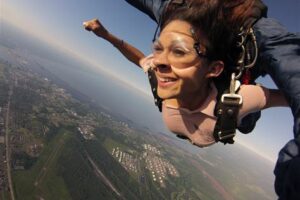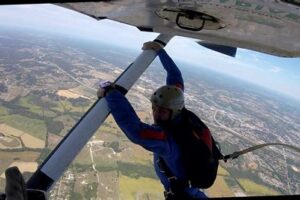Table of Contents
Curious about skydiving? Discover how safe this thrilling adventure really is. Get insights into the rigorous safety measures and training programs that make skydiving one of the safest extreme sports out there. Explore the statistics and expert opinions to gain an understanding of the risks involved and why skydiving remains a popular activity for adrenaline junkies worldwide.
Skydiving, an exhilarating adventure that often evokes a mix of fear and excitement, has captured the imaginations of thrill-seekers for decades. However, amidst the adrenaline rush and breathtaking views from thousands of feet above the ground, one question persists in the minds of many: how safe is skydiving?
Well, rest assured that skydiving today is safer than ever before. With advancements in technology, rigorous training programs, and strict safety regulations, the sport has become a well-oiled machine that prioritizes the well-being of its participants. But don’t just take our word for it; let us delve deeper into the world of skydiving and explore the measures in place to ensure your safety.
From the moment you arrive at a reputable skydiving center, you’ll be greeted by experienced professionals who are committed to making your jump as safe as possible. Before taking the leap, you’ll undergo comprehensive training sessions where you’ll learn about equipment usage, body positioning, emergency procedures, and more. This meticulous preparation helps minimize risks and instills confidence in even the most nervous first-time jumpers.
Moreover, every piece of skydiving equipment is regularly inspected, maintained, and updated to meet the highest safety standards. Parachutes, harnesses, altimeters, and automatic activation devices are all carefully scrutinized to ensure they function flawlessly. Additionally, licensed skydiving instructors undergo extensive training themselves and are held to rigorous standards to ensure they possess the expertise needed to guide you through a safe and unforgettable experience.
So, if you’ve been contemplating taking the plunge into the world of skydiving, rest assured that the safety precautions in place make it a remarkably secure adventure. From thorough training to advanced equipment and skilled professionals, skydiving provides an unparalleled adrenaline rush without compromising your well-being. So, what are you waiting for? The sky awaits!
Introduction
Skydiving is an exhilarating and adrenaline-pumping activity that provides a unique opportunity to experience the thrill of freefalling through the sky. However, many people wonder about the safety of this extreme sport. In this article, we will explore the various safety measures and precautions taken in the world of skydiving to ensure a safe and enjoyable experience for all.
The Importance of Training
In the world of skydiving, training is paramount. Before attempting your first solo jump, you are required to complete a comprehensive training program that covers all aspects of the sport. This includes learning how to properly use the equipment, understanding the physics of freefall, and practicing emergency procedures. By providing extensive training, skydiving centers ensure that participants are well-prepared and equipped with the necessary skills to handle any situation that may arise.
Equipment and Gear
The equipment used in skydiving plays a crucial role in ensuring the safety of participants. Modern skydiving gear is designed to be highly reliable and effective. Parachutes are meticulously inspected and maintained, and reserve parachutes are always available as a backup. Additionally, automatic activation devices (AADs) are commonly used to automatically deploy the reserve parachute if necessary. This redundant system provides an extra layer of safety and minimizes the risk of equipment failure.
Weather Conditions
Weather conditions play a crucial role in skydiving safety. Skydiving operations are highly dependent on favorable weather conditions, and experienced instructors closely monitor weather forecasts before each jump. Strong winds, storms, or low clouds can pose a significant risk to skydivers. If the weather is deemed unsafe, jumps are postponed or canceled altogether. This emphasis on monitoring weather conditions ensures that skydiving activities are conducted under optimal circumstances, further reducing the chances of accidents.
Drop Zone Safety Measures
Drop zones are the designated areas where skydivers land after their parachute descent. These zones are carefully selected and maintained to ensure the safety of the participants. Drop zones are typically spacious, free from obstructions, and have well-maintained landing areas. Experienced ground crew members are present to guide skydivers during landing and provide assistance if needed. Additionally, strict protocols are in place to manage air traffic and prevent collisions between skydivers.
Instructor Expertise and Certification
Skydiving instructors are extensively trained professionals who hold certifications issued by recognized governing bodies, such as the United States Parachute Association (USPA). These certifications ensure that instructors have met stringent requirements and possess the necessary knowledge and expertise to guide and assist skydivers effectively. Instructors are experienced in handling emergency situations and are trained to react calmly and efficiently in high-pressure scenarios.
Strict Safety Regulations
Skydiving is subject to strict safety regulations imposed by governing bodies, such as the USPA. These regulations cover various aspects of the sport, including equipment standards, training requirements, and operational procedures. Skydiving centers must adhere to these regulations to maintain their certification and ensure the safety of their participants. Regular inspections and audits are conducted to assess compliance, creating a culture of safety within the industry.
Statistical Safety Data
Despite its perception as a risky activity, skydiving has seen significant improvements in safety over the years. According to statistics from the USPA, the fatality rate for skydiving has steadily declined. In 2019, there were 15 fatal skydiving accidents in the United States out of approximately 3.3 million jumps, resulting in a fatality rate of 0.0045%. While any loss of life is tragic, these statistics indicate that skydiving can be a safe activity when proper precautions are taken.
Personal Responsibility
While skydiving centers, instructors, and regulations play a vital role in ensuring safety, participants also have a personal responsibility to follow instructions and guidelines. Skydivers must be honest about their physical and mental fitness to participate in the sport. It is essential to disclose any medical conditions or limitations that may affect their ability to skydive safely. Following safety protocols, paying attention during training, and using equipment correctly are all crucial elements of individual responsibility in skydiving.
The Thrill of Skydiving
Skydiving undoubtedly carries inherent risks, but with proper training, equipment, and adherence to safety protocols, it can be a remarkably safe activity. The thrill and exhilaration experienced during a skydive are unparalleled, making it a popular choice for adrenaline seekers worldwide. By understanding the safety measures in place and taking personal responsibility, individuals can enjoy the incredible adventure of skydiving while minimizing the associated risks.
Introduction to Skydiving Safety
Skydiving is considered an extreme sport that involves jumping out of an aircraft and free-falling before deploying a parachute. Although it may seem daunting at first, skydiving has evolved into a relatively safe activity due to rigorous safety protocols, advanced equipment, and comprehensive training programs.
Statistical Analysis of Skydiving Accidents
An analysis of skydiving accidents reveals that the sport has become significantly safer over the years. The United States Parachute Association reports that the fatality rate for skydiving has decreased to 0.006 fatalities per 1,000 jumps, indicating a low-risk activity when compared to other adventure sports.
Importance of Rigorous Training
The primary reason behind the safety of skydiving lies in the extensive training programs provided to jumpers. Skydiving schools meticulously instruct participants in parachute deployment, emergency procedures, body control, and equipment usage. This comprehensive training equips skydivers with the skills and knowledge necessary to handle potential risks.
Significance of Quality Equipment
Skydiving equipment plays a vital role in ensuring safety during jumps. Modern parachutes are designed with redundant safety features, such as automatic activation devices that deploy the parachute if the skydiver fails to do so. Regular maintenance and inspections of equipment are also crucial to minimize the risk of failures.
The Influence of Proper Planning
Prioritizing meticulous planning and preparation significantly enhances the safety of skydiving. Factors such as weather conditions, wind patterns, and freefall altitudes are carefully assessed before each jump. Professional skydiving centers follow strict guidelines to decide whether it is safe to jump, ensuring the highest level of safety for participants.
Importance of Experienced Instructors
Having experienced and certified instructors is crucial for maintaining safety in skydiving. These professionals not only impart knowledge and skills but also continually assess jumpers’ proficiency and readiness. Their expertise and guidance further reduce the chances of accidents and ensure a safe and enjoyable skydiving experience.
Mitigating Risks through Regulations
Regulations within the skydiving industry play a significant role in maintaining safety standards. Organizations such as the United States Parachute Association enforce rules and regulations, ensuring that skydiving centers adhere to strict safety protocols. These regulations cover everything from equipment maintenance to instructor certifications, reducing potential risks.
Constant Evolution in Safety Practices
Safety within the skydiving industry is an ongoing priority, resulting in continuous improvements and developments in safety procedures and equipment design. Researchers and manufacturers are constantly working to enhance parachute technology and safety systems, providing additional layers of protection to skydivers.
Overall, while skydiving does involve inherent risks, the implementation of rigorous training, high-quality equipment, thorough planning, experienced instructors, and regulatory guidelines contribute to making it a relatively safe adventure sport. By prioritizing safety at every level, the skydiving industry continues to take significant steps towards minimizing risks and providing skydivers with unforgettable yet secure experiences.
Skydiving is considered an exhilarating and adrenaline-pumping activity that allows individuals to experience the thrill of freefalling through the sky. However, when it comes to safety, many people question just how safe skydiving really is. As a professional in the field, I can confidently say that skydiving is a well-regulated sport with strict safety protocols in place. Let’s explore some key points regarding the safety of skydiving:
- Regulations and Licensing: The skydiving industry is governed by various regulatory bodies, such as the United States Parachute Association (USPA). These organizations enforce rigorous standards for training, equipment, and operational procedures. Skydiving centers must adhere to these regulations and maintain proper licensing to ensure the highest level of safety.
- Training: Before taking part in a skydive, participants are required to undergo thorough training sessions. These sessions cover essential topics such as parachute operation, emergency procedures, body positioning, and landing techniques. Instructors provide hands-on training and ensure that individuals have a solid understanding of the necessary skills before jumping from an aircraft.
- Equipment: The equipment used in skydiving is meticulously inspected and maintained. Parachutes are designed to withstand extreme forces and undergo regular inspections to ensure their airworthiness. Additionally, skydivers wear safety gear, including helmets and altimeters, which further enhance their safety during the jump.
- Instructor Expertise: Skydiving centers employ highly trained and experienced instructors who are certified by recognized governing bodies. These professionals have extensive knowledge of the sport and are skilled in teaching proper techniques and safety measures. They accompany novice skydivers during their jumps, providing guidance and support throughout the entire experience.
- Weather Conditions: Skydiving operations are highly dependent on weather conditions. Centers closely monitor meteorological factors, such as wind speed, cloud cover, and visibility, to determine whether it is safe to jump. If conditions are deemed unsafe, jumps are postponed or canceled altogether, ensuring the safety of participants.
- Emergency Preparedness: Although rare, emergencies can occur during skydiving. However, instructors are trained to handle such situations effectively. They are equipped with reserve parachutes and have extensive knowledge of emergency procedures. Skydiving centers also have protocols in place to quickly respond to any critical situations that may arise.
In conclusion, skydiving is a thrilling adventure sport that prioritizes safety above all else. With strict regulations, comprehensive training, well-maintained equipment, and experienced instructors, the industry goes to great lengths to ensure the safety of its participants. While there are risks associated with any extreme sport, skydiving remains a relatively safe activity when conducted under proper supervision. So, if you have ever dreamt of experiencing the rush of freefalling through the sky, rest assured that skydiving is indeed a safe endeavor.
Thank you for taking the time to visit our blog and explore the thrilling world of skydiving. As you may have learned from our previous articles, skydiving is an exhilarating adventure that offers a unique perspective and an unmatched adrenaline rush. However, it is only natural to question the safety of such an extreme sport. In this closing message, we will address your concerns and provide you with a comprehensive overview of how safe skydiving truly is.
First and foremost, it is important to emphasize that skydiving is a highly regulated activity. The Federal Aviation Administration (FAA) in the United States, along with similar authorities in other countries, sets strict guidelines and regulations that all skydiving centers must adhere to. These regulations cover everything from the maintenance of equipment to the training and certification of instructors. Before jumping out of a plane, you can rest assured that you will be in the hands of professionals who prioritize your safety above all else.
Additionally, skydiving equipment undergoes rigorous inspections and maintenance checks. Parachutes, harnesses, and helmets are routinely examined to ensure they are in excellent condition and ready for use. Most skydiving centers employ professional riggers who meticulously inspect each piece of equipment before it is used. These measures help to minimize the risk of any equipment failure during your jump.
Furthermore, one of the most important aspects of skydiving safety is training. All first-time skydivers are required to complete a comprehensive training course before making their first jump. During this course, you will learn about proper body positioning, emergency procedures, and how to deploy and control your parachute. You will also receive thorough instruction on how to respond to different scenarios that may arise during your descent. This training not only equips you with the necessary knowledge but also enhances your confidence and reduces any anxiety you may have about the experience.
In conclusion, while skydiving may seem like a daring and risky activity, it is actually a highly regulated and safe sport. The stringent regulations, regular equipment inspections, and comprehensive training programs all contribute to ensuring your safety during every skydive. So, if you have always dreamt of soaring through the skies and experiencing an unparalleled rush of adrenaline, don’t let safety concerns hold you back. Take the leap and embark on the adventure of a lifetime – skydiving is an experience you won’t soon forget..
Below are some commonly asked questions about the safety of skydiving:
1. Is skydiving safe for beginners?
Skydiving can be a safe activity for beginners when proper precautions and training are followed. It is essential to undergo thorough training with a certified instructor and use professionally maintained equipment to minimize any potential risks.
2. What are the risks associated with skydiving?
Like any adventure sport, skydiving carries inherent risks. These include equipment malfunctions, parachute deployment issues, freefall instability, and injuries upon landing. However, with proper training, adherence to safety protocols, and using reliable gear, the risks can be significantly mitigated.
3. How often do skydiving accidents occur?
Skydiving accidents are relatively rare. According to the United States Parachute Association, the average fatality rate for skydiving is approximately one in every 253,669 jumps. This statistic highlights that, with proper training and following safety guidelines, skydiving can be a reasonably safe activity.
4. Can weather conditions affect skydiving safety?
Yes, weather conditions can significantly impact the safety of skydiving. Strong winds, rain, fog, or thunderstorms can make skydiving unsafe and lead to the cancellation or rescheduling of jumps. Professional skydiving centers prioritize safety and closely monitor weather conditions to ensure a safe experience for all participants.
5. Are there any age or health restrictions for skydiving?
Most skydiving centers have age restrictions and require participants to be at least 18 years old. However, some centers offer tandem skydiving for younger individuals with parental consent. Additionally, certain medical conditions may prevent someone from skydiving due to safety concerns. It is advisable to consult with a doctor and inform the skydiving center about any health issues before attempting a jump.
6. What measures are in place to ensure skydiving safety?
Skydiving centers prioritize safety through various measures, including rigorous training programs, regular equipment inspections, and adherence to established safety guidelines. Instructors are highly trained professionals who guide beginners throughout the entire process, ensuring a safe and enjoyable experience for all participants.
7. Can I reduce the risks associated with skydiving?
While skydiving will always carry some level of risk, you can take steps to reduce those risks. Choose a reputable skydiving center with experienced instructors, follow their instructions meticulously, and ask any questions you may have during the training process. Additionally, it is essential to maintain physical fitness and disclose any medical conditions that may affect your ability to skydive safely.
Remember, skydiving can be an exhilarating and safe adventure when approached responsibly, with proper training, and under the guidance of experienced professionals.






